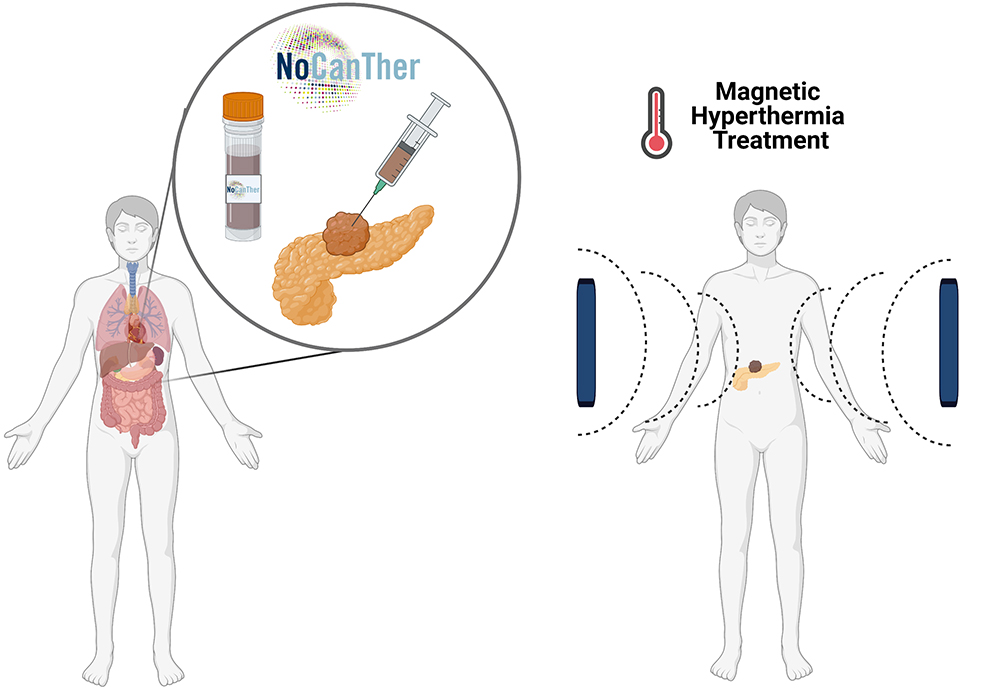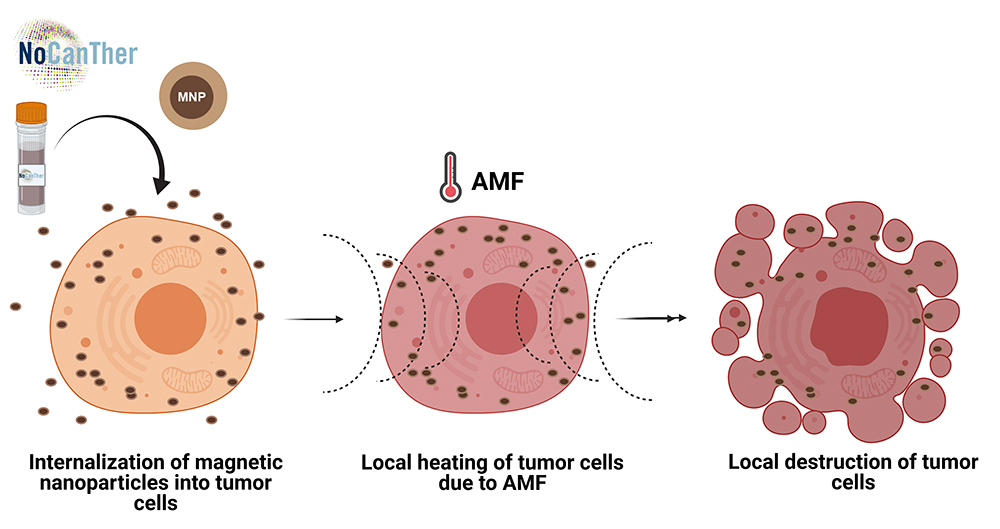IMDEA Nanociencia coordinates NoCanTher, a European project now entering a clinical study phase -testing magnetic nanoparticles for hyperthermia against pancreatic cancer
 |
|
Magnetic nanoparticles are implanted in the tumor, followed by the application of an alternating magnetic field to enhance the therapeutic effect of the standard of care. Credit: IMDEA Nanociencia. |
25.02.2021
- This important milestone marks the culmination of over ten years’ of scientific work and is one of the last phases of the NoCanTher project, coordinated by IMDEA Nanociencia.
- The study will be led from Spain and carried out at two sites -Vall d'Hebron Institute of Oncology (Barcelona) and Hospital Universitario de Fuenlabrada (Madrid).
- This novel approach will now be tested in patients with locally advanced pancreatic cancer.
Nanomedicine has emerged as a potential therapy for pancreatic cancer, a disease with a 5-year survival rate as low as 5%. Novel approaches are therefore required to increase the efficacy of chemotherapy. The international project NoCanTher was launched in 2016 to test the use of magnetic nanoparticles in treating locally advanced pancreatic cancer, and is coordinated from IMDEA Nanociencia, Madrid.
NoCanTher now enters its final phase with the start of a clinical study aimed at patients with unresectable, locally advanced pancreatic cancer that has not metastasized, who have palliative chemotherapy as the only therapeutic alternative. This population accounts for 20% of patients with pancreatic cancer.
This clinical study is based on the results obtained from the preclinical stages of NoCanTher, where IMDEA Nanociencia researchers, led by Prof. Rodolfo Miranda (Director of IMDEA Nanociencia) and Prof. Álvaro Somoza (Senior Research Professor and Head of the NanoBiotechnology Group), have implemented the experience of the Institute in the preparation and scale-up of magnetic nanoparticles and importantly, the characterization of this type of nanomaterials. “This project is the culmination of over ten years’ of work, and is a great example of the importance of multidisciplinary collaboration. Chemists, physicists and biologists from IMDEA Nanociencia collaborated with academia and industry in five European countries to address the challenge of taking an idea, partly developed in the laboratories here at IMDEA Nanociencia in Madrid, to enter into a clinical study”, outlines Prof. Miranda.
The research focused on the development of iron magnetic nanoparticles that generate magnetic hyperthermia, where the heat generated can be used to sensitize cancer cells to the standard of care, and even destroy them directly. Prof Somoza explains, "We have been working in close collaboration with companies and hospitals to ease the translation of developments from the Institute to the industrial sector and the clinic. Particularly, we have been involved in the scale-up process of the nanoparticles and the implementation of a quality system. In addition, equipment to certify the quality of the nanoparticles and software to assist the clinicians during the hyperthermia process have also been developed at the Institute."
Vall d’Hebron Institut de Recerca (VHIR, Barcelona), and the Hospital of Fuenlabrada (HUF, Madrid), assessed the utility of nanoparticles in animal models in which pancreatic cancer was either induced or patient-derived tumours were implanted. The study demonstrated that the hyperthermia generated when nanoparticles are injected directly into the tumour reduces the volume of the tumour and induces physical changes that favour the impact of chemotherapy on cancer cells. "This demonstrates a significant synergy between the hyperthermia generated by the nanoparticles and chemotherapy for pancreatic cancer", explains Simón Schwartz Jr, director of the VHIR CIBBIM-Nanomedicine Group.
These nanoparticles are heated after the application of an alternating magnetic field and boost the effects of concurrently-administered chemotherapy; the gold standard therapy for these patients. "We think that, with this novel technique, we can change the characteristics of the tumour and control the disease locally. This pilot study represents an important step forward in opening up new therapeutic avenue for patients with locally advanced pancreatic cancer, for whom there are no other alternatives but chemotherapy", says Teresa Macarulla, Medical Oncologist at the Vall d’Hebron University Hospital, and Principal Investigator at Vall d'Hebron Institute of Oncology, who leads NoCanTher’s clinical study.
The local heat induced by nanoparticles increases the efficacy of chemotherapy
 Our approach based on magnetic iron oxide nanoparticles makes it possible to apply heat solely in the region where these nanoparticles are present, in this case, the pancreatic tumour. By this technique, chemotherapy does not damage the healthy tissue surrounding the tumour. Hyperthermia transforms electromagnetic energy into heat, which, combined with standard chemotherapy, destroys tumour cells and controls the local growth of the tumour. A magnetic field generator specifically designed and built to generate thermal energy inside the tumour will be used in this study.
Our approach based on magnetic iron oxide nanoparticles makes it possible to apply heat solely in the region where these nanoparticles are present, in this case, the pancreatic tumour. By this technique, chemotherapy does not damage the healthy tissue surrounding the tumour. Hyperthermia transforms electromagnetic energy into heat, which, combined with standard chemotherapy, destroys tumour cells and controls the local growth of the tumour. A magnetic field generator specifically designed and built to generate thermal energy inside the tumour will be used in this study.
Although this is a relatively new field of research, this approach may be a feasible option for cancer patients, especially for those who do not respond to standard treatment and in whom external beam radiotherapy can cause high toxicity.
A long-haul multidisciplinary project that ends with a clinical study
Under the coordination of IMDEA Nanociencia, eleven national and international research centres are members of the NoCanTher – Nanomedicine upscaling for early clinical phases of multimodal cancer therapy – Consortium: BioKeralty Research Institute (Miñano, Spain), ImmuPharma (London, England), Chemicell (Berlin, Germany), University Hospital (Jena, Germany), Resonant Circuits (London, England), Vall d’Hebron Research Institute (VHIR) (Vall d’Hebron Barcelona Hospital Campus, Barcelona, Spain), Trinity College (Dublin, Ireland), Université Paris Diderot (Paris, France),
Vall d’Hebron Institute of Oncology (VHIO) (Vall d’Hebron Barcelona Hospital Campus, Barcelona, Spain), Hospital Universitario de Fuenlabrada (Madrid, Spain).
This project receives funding from the European Union’s Horizon 2020 research and innovation programme under grant agreement No 685795.
For more information about the project, please visit: www.nocanther-project.eu.
Contact
Prof. Rodolfo Miranda
contacto.nanociencia [at]imdea.org
Prof. Álvaro Somoza
alvaro.somoza [at]imdea.org
IMDEA Nanociencia Outreach Office
This email address is being protected from spambots. You need JavaScript enabled to view it.
+34 91 299 87 12
Twitter: @imdea_nano
Facebook: @imdeananociencia
Instagram: @imdeananociencia
Source: IMDEA Nanociencia and Vall d’Hebron Instituto de Oncología




